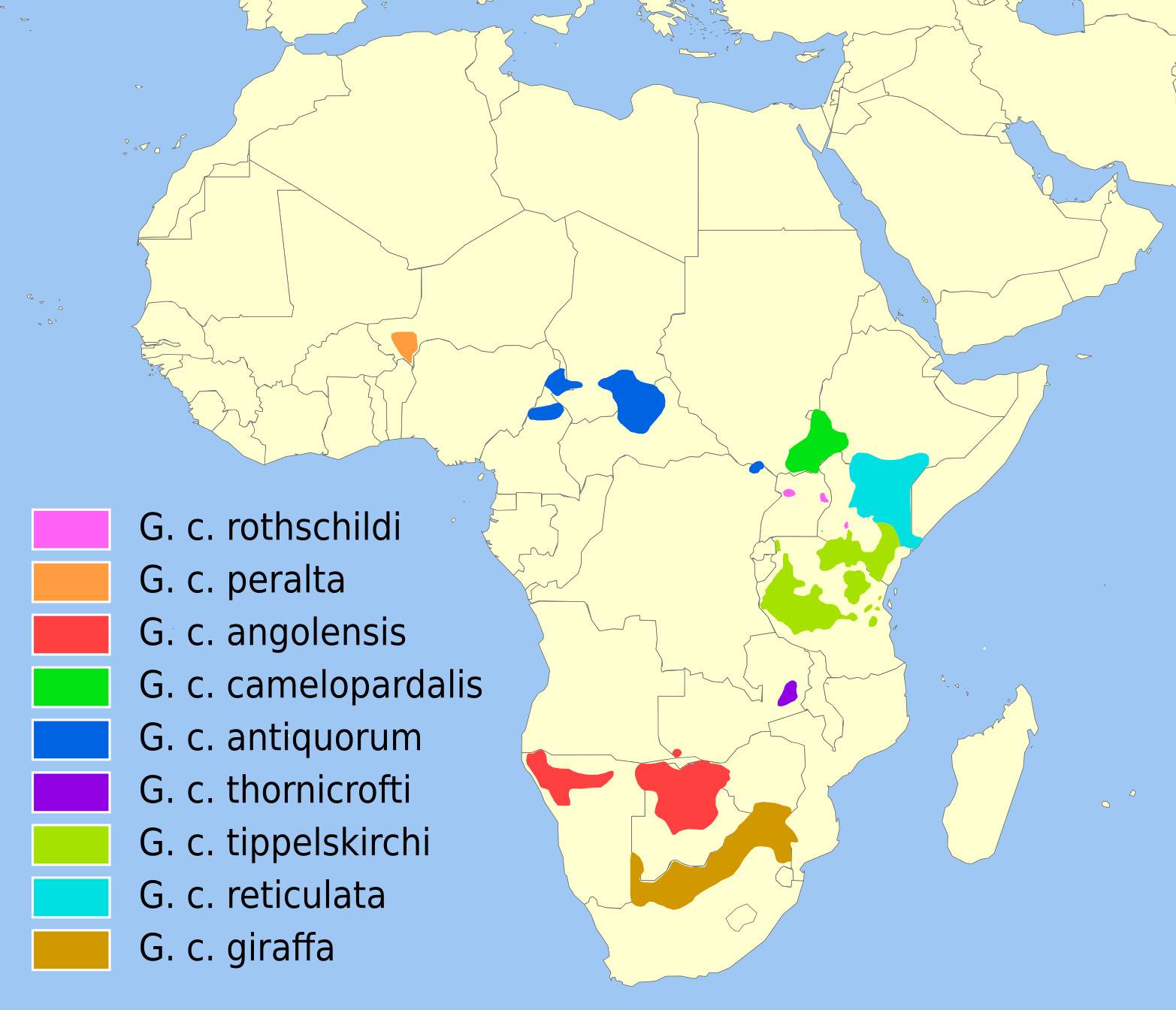African Safari Animals
African Safari Animals – And Where to Find Them
African Safari Animals - The Big 5
I wrote a post a short while ago titled Safari Animals ‘Big Five of Africa‘ where I detailed Africa’s iconic Big 5 African safari animals. These famous ‘five’ known the world over are animals native to Africa, easily recognised and are the measure of a good African safari sighting. They are the….
1. African Elephant
2. African Lion
3. Rhinoceros
4. African Leopard
5. Cape Buffalo
The Big Five have captured the imaginations of visitors to Africa for centuries. … Luckily, any of the ‘Big Five’ African safaris will offer many opportunities for numerous sightings of Africa’s other animals, which can offer just as much excitement as the ‘Big Five’
Here are a few more African safari animals …..
1. Giraffe (Giraffa camelopardalis)
Family: Giraffidae
Giraffes are one of the worlds iconic species and recognised by almost everybody on the planet. However, these are African safari animals many people overlook and are probably unaware that there are nine different sub-species of Giraffe in Africa. Three of these species are found in Kenya, the reticulated giraffe (Giraffa camelopardalis reticulata; also known as the Somali giraffe), Rothschild’s giraffe (Giraffa camelopardalis rothschildi), and the Masai giraffe (Giraffa camelopardalis tippelskirchi; also known as the Kilimanjaro giraffe).
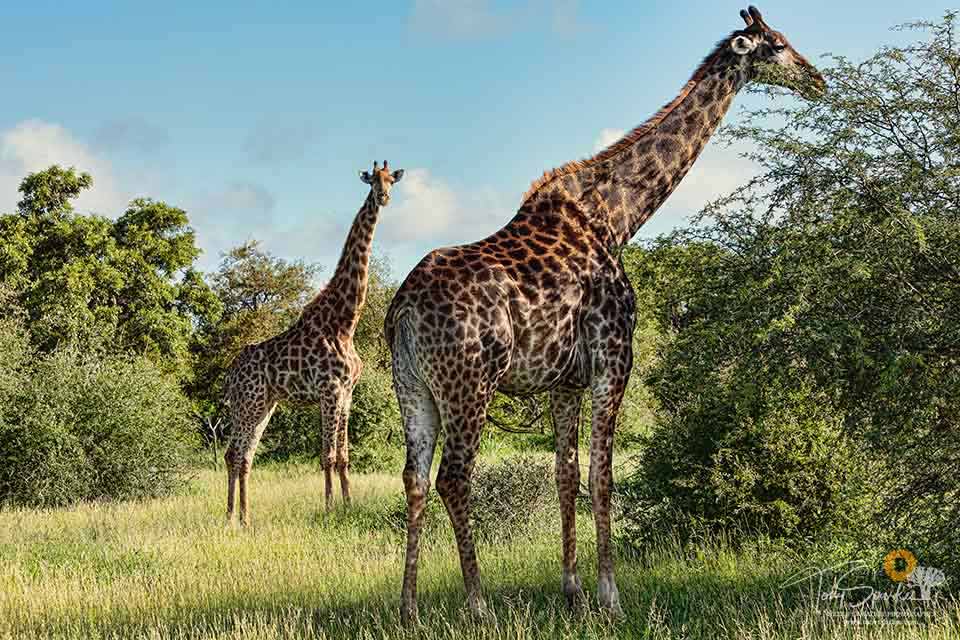
African Safari Animals - Area's to find species of Giraffe?
With the above in mind and the help of the distribution map on the right, those on safari in the various countries and locations should be able to identify which sub-species of Giraffe you are actually seeing.
Endangered - African Safari Animals
The most endangered species of Giraffe is undoubtedly Rothschild’s giraffe (Giraffa camelopardalis rothschildi). Rothschild’s are highly endangered because they frequently hybridise with other subspecies; only a few hundred “pure” individuals are thought to exist in the wild.
Giraffes are listed as vulnerable under the IUCN Red List, and they currently inhabit a much smaller region than their ancestors did. As mentioned above, some subspecies are more threatened than others. There are, for example, fewer than 400 of the Peralta subspecies, and fewer than 700 of the rothschildi; in fact, these two species are rarer than pandas, mountain gorillas, blue whales and tigers, combined.
Identification
Reticulated Giraffes
- The reticulated giraffe has much whiter lines between the brownish (or sometimes even reddish) patches on its pelt, and the patches are bordered by very smooth lines.
Rothschild's & Masai Giraffes
- The Rothschild’s and Masai giraffes have much creamier lines in between their patches, and the patches have more jagged edges. The key to telling these two subspecies apart is the legs: Masai giraffes’ legs are decorated with brown spots all the way down to their feet, but Rothschild’s giraffes appear to be wearing cream-colored socks.
Some Giraffe Facts:
Size & Weight
Seeing a giraffe for the first time can be pretty spectacular because they are so gigantic; indeed, they are the tallest extant terrestrial animals and also, unsurprisingly, the largest ruminant. Giraffes are also known for having horns–or, more accurately, ossicones, which are horn-like growths of ossified cartilage (not bone tissue) that are permanently covered in skin and fur (rather than a velvet that can be rubbed off).
Females grow up to 14 feet (4.3 m) tall and weigh up to 1,500 lbs. (680 kg), while males grow up to 18 feet (5.5 m) tall and weigh up to 3,000 lbs. (1,360 kg). With such a massive body, it makes sense that the giraffes’ organs and other body parts are equally huge. Their tongues are a substantial 21 inches (53 centimetres) long.
Habitat
Giraffes live in savannas throughout Africa. They like semi-arid, open woodlands that have scattered trees and bushes, making the savannas perfect for these animals.
Diet
Giraffes are herbivores, which means they eat only plants. Their long necks allow them to reach leaves, seeds, fruits, buds and branches high up in mimosa and acacia trees. All bits of the giraffes’ mouths are quite tough since they have to withstand exposure to the sharp thorns of acacia trees. This tolerance allows an individual giraffe to make its way through over 30 kg of foliage each day. While there long necks are advantageous for feeding, it makes drinking a bit awkward; giraffes must splay out their legs in order to achieve a position that allows them to lap up and swallow water.
Reproduction
As in cattle, female giraffes are called cows, while the males are called bulls.
- Giraffe mate at any time of the year
- Sexual maturity of the female is at 48-60 months, the male is at 42 months.
- The gestation period is around 14 months.
- There is usually only one calf, very rarely twins.
- Baby giraffes are called calves
- During birth, the calf will drop to the ground, since mother giraffes give birth standing up. The fall can be as far as 5 feet (1.5 m), according to National Geographic.
- New calves are quite large, at 6 feet tall (1.8 m), 100 to 150 lbs. (45 to 68 kg),
- At just an hour after birth, they can stand up and walk around.
- The animals can live 10 to 15 years in the wild and 20 to 25 years in captivity.
Giraffe mothers often take turns watching over the calves. Sometimes, though, the mother giraffe will leave the calf by itself. When this happens, the infant will lie down and wait for its mother to return.
Fun Facts
- Just like human fingerprints and zebra stripes, the coat pattern of a giraffe is unique to that animal.
- You will often see giraffes walking around with birds on their backs. These birds are called oxpecker birds (Buphagus africanus). They eat bugs that live in the giraffe’s coat and alert the animals to danger by chirping loudly.
- You would never hear them make a noise. This is because giraffes communicate using noises that are too low for humans to hear
Where to find Giraffes
You can find Giraffes in the following area’s.
- Giraffe.c. rothschildi – Murchison Falls Park (Uganda) & Lake Nakuru National Park (Kenya)
- Giraffe.c. peralta – Niger
- Giraffe.c. angolensis – Namibia, South West Zambia and Northern Botswana
- Giraffe.c. camelopardalis – Ethiopia, DRC & South Sudan
- Giraffe.c. antiquorum – Southern Chad & Northern Cameroon
- Giraffe.c. thornicrofti – South Luangwa National Park (Zambia)
- Giraffe.c. tippelskirchi – Serengeti National Park (Tanzania) & the Masai Mara (Kenya)
- Giraffe.c. reticulata – Samburu National Reserve (Kenya)
- Giraffe.c. giraffa – Kruger National Park (South Africa) Hwange National Park (Zimbabwe)
Giraffe Videos
More Giraffe Video’s
2. Zebra (Equus spp)
Family: Equidae
There are three species of Zebra distributed across much of southern and eastern Africa. Plains or Burchell’s zebra (Equus quagga or E. burchellii), Grevy’s zebra (Equus grevyi), and mountain zebra (Equus zebra). It is readily accepted that there are two subspecies of the mountain zebra; the Cape mountain zebra (Equus zebra zebra) and the Hartmann’s mountain zebra (Equus zebra hartmannae).
With their familiar horse-like physique and their distinct black and white striping pattern, Zebra’s are among the most recognisable of all the worlds mammals. They are native to both the plains and mountains of Africa. Zebra’s occur in a variety of habitats, such as grasslands, savannas, woodlands, mountains and coastal hills. Zebras are members of the genus Equus, which also includes asses and horses.
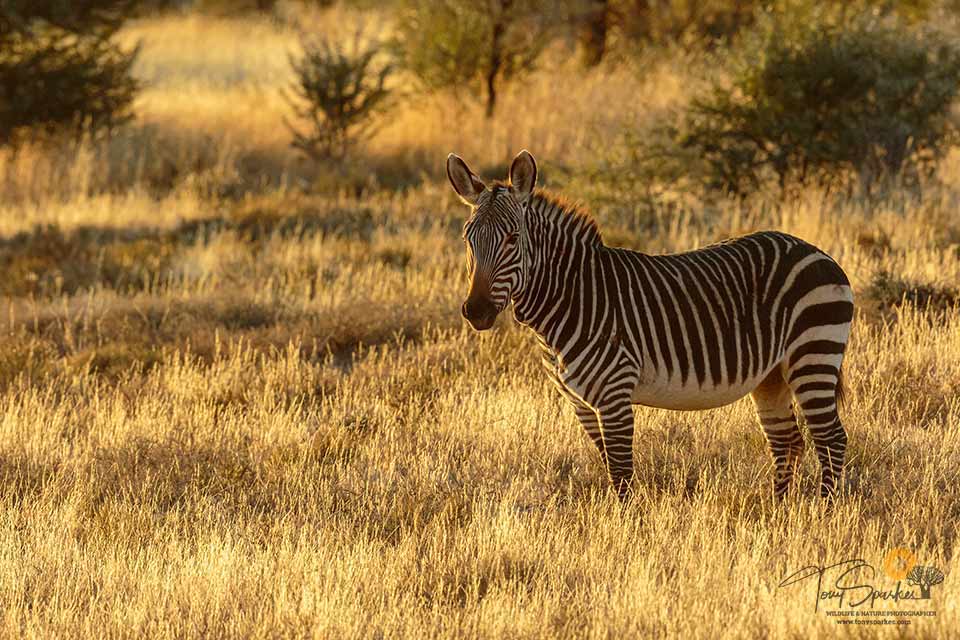
African Safari Animals - Area's to find species of Zebra?
The plains zebra is found in several eastern and southern countries, the mountain zebra is found in Southern Africa and the Grevy’s zebra is found in Eastern Africa.
Though they all live in Africa, each species of zebra has its own home area. Plains zebras live in the treeless grasslands and woodlands of eastern and southern Africa. The Grevy’s zebra lives in in the arid grasslands of Ethiopia and Northern Kenya. The mountain zebra is found in South Africa, Namibia and Angola.
Endangered - African Safari Animals
According to the IUCN’s Red List of Threatened Species, the plains zebra (Equus quagga) population is listed as decreasing and Near Threatened, while the mountain zebra (Equus zebra) although the population is ‘increasing’ is considered Vulnerable. and the Grevy’s zebra (Equus grevyi) population is stable but Endangered. The red list also lists Hartmann’s zebra (Equus zebra ssp. hartmannae) a subspecies of the mountain zebra) as an increasing population but listed as Vulnerable.
Identification
Plains Zebra
Have stripes that cover their sides and meet in the centre of their bellies, stripes are apparent even on the foals. The black stripes can fade and even disappear altogether as they go down the legs, they have shadow stripes between the black. Their necks are smooth underneath – no dewlap. Look at their noses too, plains zebra have black nose’s with stripes meeting it.
Mountain Zebra
The mountain zebra’s vertical stripes stop at their sides leaving a white-belly with a single black stripe running down the center from neck to tail. There is usually no shadow stripe between the dark stripes, and the stripes stay distinct all the way down the legs. They have a dewlap (look for an obvious hanging fold of skin) under their necks
Grevy’s Zebra
The Grevy’s zebra’s stripes are the thinnest and most delicate of all three species – this is especially evident at the rump area. Grevy’s zebra has a snow-white belly. The stripes are always distinctively black and white – no shadow striping for the Grevy’s zebra. They are the largest zebra species, with oval shaped ears that are much bigger than their plains or mountain zebra cousins. They have a white patch above a brown patch that sits above their black nose.
Some Zebra Facts:
Size & Weight
Plains zebra are about 1.2–1.3 m (47–51 in) to the shoulder with a body ranging from 2–2.6 m (6.6–8.5 ft) long with a 0.5 m (20 in) tail. Plains zebra can weigh up to 350 kg (770 lb), males being slightly bigger than females.
The Grevy’s zebra is the largest of all zebra and stand about 1.45–1.6 m (4.8–5.2 ft) high. It is 2.5–2.75 m (8.2–9.0 ft) from head to tail with a 55–75 cm (22–30 in) tail. Grevy’s zebras around weigh 350–450 kg (770–990 lb) also slightly bigger than females.
Mountain Zebra stand about from 1.16 to 1.5 m (3 ft 10 in to 4 ft 11 in). Have a head-and-body length of 2.1 to 2.6 m (6 ft 11 in to 8 ft 6 in) and a tail of 40 to 55 cm (16 to 22 in) long. Mountain Zebra weigh around 204 to 372 kg (450 to 820 lb)
Habitat
Zebra habitat can include open plains, semi-desert, open woodlands, and even mountainous regions. This variation occurs because there are three types of zebra.
Grevy’s zebra lives in the most dryer habitat of the three, the sub-desert region of northern Kenya and southern Ethiopia. Burchell’s zebra is found in a more varied range of habitats, ranging from savanna, to open woodland and scrub, to grassland. It also can occur in hilly, or even mountainous, country up to an elevation of 4,400 meters. It’s much more dependent on the availability of freshwater than is Grevy’s zebra. Finally, as its name suggests the mountain zebra generally occurs in mountainous or hilly regions
Diet
All Zebra are herbivores and are grazers not browsers. Although when food is scarce they can be prone to some browsing. Almost 90% of their diet is made up of grass. Unlike many of the large ungulates of Africa, the zebra does not require (but still prefers) short grass to graze. Zebra’s eat a wide range of different grasses, preferring young, fresh growth where available.
Zebras need a lot of water and are water dependant. Meaning that they need to drink often and will not be far from a water source. Burchells or plains Zebra, for instance, are strictly water-dependent; therefore they rarely move more than 12 km (7 .5 miles) from waterholes.
Reproduction
A female zebra is called a mare and a male a stallion, a baby zebra is called a foal just like horses.
- Female zebras mature earlier than males.
- Mare’s may have their first foal by the age of three.
- Males are not able to breed until the age of five or six years old.
- Female zebra are sexually receptive for up to 5 days and mating takes place during this period.
- Copulation is repeated once every 1–3 hours for about a day.
- Mares may give birth to one foal every twelve months.
- Mares nurse the foal for up to a year.
- Like horses, zebras are able to stand, walk and suckle shortly after they are born.
- Mares conceive one offspring; twins have never been recorded.
- A Zebra gestation period is between 360 and 390 days.
- Foals are born at any time of the year, with birth rates peaking during summer (October–March).
- After birth, they can stand up within 10 minutes, walk within 20 minutes and suckle within 6-7 minutes.
Zebra foals are brown and white when born not black and white. Zebra can live up to 9 years in the wild and in captivity up to 40 years.
Fun Facts
- Zebra are part of the equidae family along with horse and donkeys.
- There are a number of different theories which attempt to explain zebra’s unique stripes with most relating to camouflage.
- Zebra crossings (pedestrian crossings) are named after the black and white stripes of zebras.
- Zebras run from side to side when being chased by a predator.
- Zebras have excellent eyesight and hearing.
- Zebras stand up while sleeping.
- The ears of a zebra show its mood.
Where to Find Zebra
You can find Zebra’s in the following area’s.
- Plains Zebra (Equus quagga, formerly Equus burchellii) – Kruger National Park (South Africa) & Serengeti National Park (Tanzania) Masai Mara (Kenya)
- Cape Mountain Zebra (Equus zebra zebra) Mountain Zebra National Park (South Africa)
- Hartmann’s Mountain Zebra (Equus zebra hartmannae) – Western semi-arid regions of Namibia, from where it also ranges into Angola.
- Grevy’s Zebra (Equus grevyi) – Ethiopia and Northern Kenya,
Zebra Video's
More Zebra Video’s
3. Hippopotamus (Hippopotamus amphibius)
Family: Hippopotamidae
Another of Africa’s peculiar looking animals is the Hippopotamus a large, mostly herbivorous, semiaquatic mammal and ungulate native to sub-Saharan Africa. It is one of only two extant (living) species in the family Hippopotamidae, the other being the pygmy hippopotamus. The name comes from the ancient Greek for “river horse”
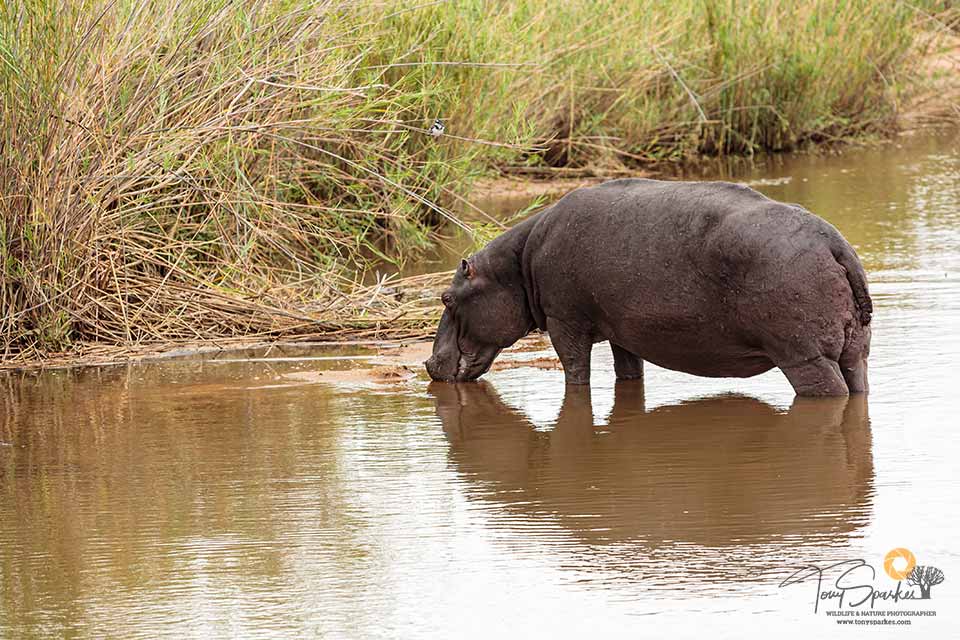
African Safari Animals - Area's to find species of Hippopotamus?
As stated above there are two hippo species found in Africa. The common hippo (Hippopotamus amphibius), found in East Africa, and south of the Sahara. The other much smaller species of hippo is the pygmy hippopotamus (Choeropsis liberiensis). These small hippos are limited to very restricted ranges in West Africa, and is a shy, solitary forest dweller, and is now endangered.
The common hippopotamus is among the most dangerous animals in the world, it is highly aggressive and very unpredictable. Common Hippos are the world’s deadliest large land mammal, killing an estimated 500 people per year in Africa.
Endangered - African Safari Animals
The Pygmy Hippopotamus (Choeropsis liberiensis) population is decreasing. Native to the forests and swamps of West Africa the Pygmy Hippo has an IUCN status of “Endangered.” Recent population estimates indicate there may be fewer than 3,000 pygmy hippos left in the wild.
The common hippo population, however, is officially stated as ‘stable’ and has an IUCN status of ‘Vulnerable‘. Recent estimates show however a 10 to 20 per cent decline in their population. Experts estimate that the common hippo population will drop more than 30 per cent in the next 30 years.
Both types of hippos are threatened by habitat loss due to logging and human settlement. Pygmy hippos are particularly sensitive to habitat loss. Hunters also kill both common and pygmy hippos for the ivory in their teeth, as well as for meat.
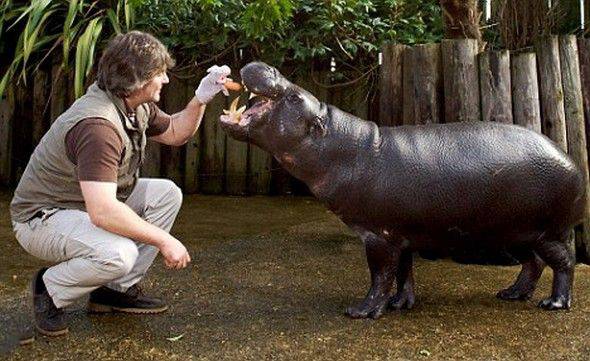
Identification
The hippopotamus is easily recognised in the field as its like no other mammal. Besides the obvious size difference between the pygmy hippo and the common hippo, differences between male and female hippos are not really very different either.
The differences between male and female hippos of the same species generally are again around size, with male hippos being generally larger than females. When you look closer though, another difference between male and female hippos can be seen.
The male hippo has much larger tusks than females reaching almost 50 cm (20in) in length. Due to the extreme size of these lower tusks, they would push up against the top jaw and lips forming a large bulge or bumps seemly next to the nostrils. The tusks of the female hippo are not nearly as long as that of the male and therefore do not have the same effect on the upper lip. On average a third of the tusk of a bull hippo can be seen in the mouth whilst two-thirds are located inside of the jaw bone
Some Hippo Facts:
Size & Weight
Hippos are the third-largest living land mammals, after elephants and white rhinos. They grow to between 3.3 to 5 meters (10.8 and 16.5 feet) long and up to 1.6 m (5.2 feet) \ tall at the shoulder. The average female weighs around 1,400 kilograms (3,000 lbs) while males weigh 1,600 to 4,500 kg (3,500 to 9,920 lbs)
Pygmy hippos adults stand about 75–100 cm (2.46–3.28 ft) high at the shoulder, are 150–175 cm (4.92–5.74 ft) in length and weigh 180–275 kg (397–606 lb).
Habitat
In sub-Saharan Africa, common hippos need permanent abundant open water like rivers, dams, or pools in rivers where they can submerge to keep their skin cool and moist. Considered amphibious animals, hippos spend up to 16 hours per day in the water. Hippos also like to have ‘sandbanks’ where they can bask in the sun for long periods of time. Another important factor is of course food. Hippo’s as herbivores need enough ‘grazing’ in the area.
Pygmy Hippo’s, however, are reclusive and nocturnal have a small range and are only found in the interior portions of West Africa. They are more common in Liberia than anywhere else. Pygmy hippos prefer forested areas and live near streams, rivers, and swamps.
Diet
Hippos have a healthy and mostly herbivorous appetite. Their diet consists almost entirely of grass. Adults eat about 35 kg (80 lbs) of grass, travelling up to 10 kilometres (6 miles) each night to ensure they get all they need. Hippo’s also eat fruit that they find during their nightly scavenging.
Reproduction
As giraffes above, female hippo’s are called cows, while the males are called bulls. Cow’s give birth to a calf.
- Bulls must have a ‘territory’ in order to mate with the cows. In fact, only the dominant bulls get the opportunity to mate, with around 90% of males generally being excluded.
- Female hippos reach sexual maturity at five to six years males reach maturity at around seven to eight years
- Hippos usually mate between May and June when the cow’s reach peak fertility for a three-day period.
- Bulls check the cow’s reproductive condition by smelling her urine.
- Mating occurs in the water, with the female submerged for most of the encounter.
- The hippo gestation period is eight months
- A cow typically gives birth to only one calf, although twins also occur.
Fun Facts:
- Hippo’s are warm-blooded mammals
- Hippo’s have very delicate skin that needs to be protected from the sun.
- Hippo produces there own natural sunscreen called “blood sweat” or “red sweat.
- Hippos rely on water to keep its skin moist and its body temperature cool.
- A hippo has an enormous mouth and it can open up to a whopping 150-degree angle.
- Hippos don’t use their incisors to eat; they pluck plant parts with their lips and chew on them with their molars.
- Hippos, living in groups of up to 40 animals are called a pod, herd, school or bloat.
- A common hippo has a ‘bite force’ of about 2000 pounds per square inch. Where a human male has 200 pounds per square inch.
- A common hippos front teeth (incisors) can reach an incredible 400mm (1.2 ft) in length. That’s not all the canine teeth can grow to a whopping 450mm (1.5 ft) in length.
- Hippos do not and can not swim, they in actual fact are running along the bottom.
- Hippos can not breathe underwater they breathe with their nostrils when above the water and their nostrils close when under the water.
- A adult Hippo can hold its breath for up to 5 minutes.
- Life span of a hippopotamus is 40-50 years.
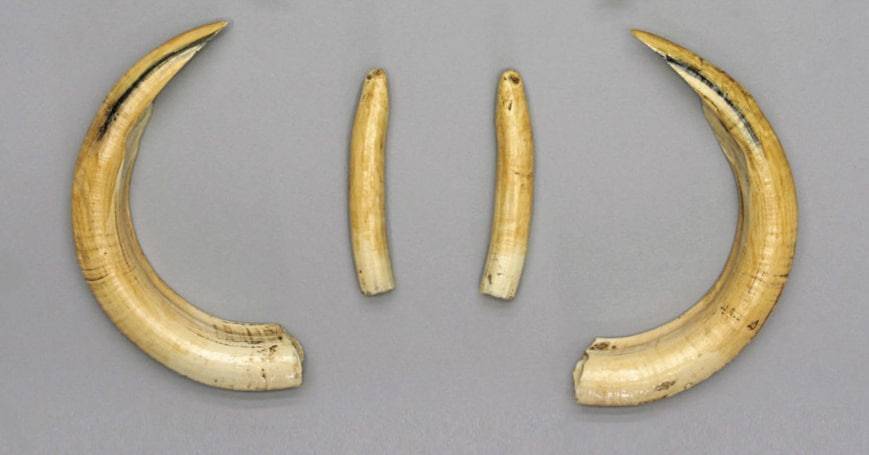
Where to find Hippopotamas
You can find Hippopotamus in the following area’s.
- Common Hippopotamus (Hippopotamus amphibius) – Kruger National Park (South Africa), Chobe National Park (Botswana) and Queen Elizabeth National Park (Uganda)
- Pygmy Hippopotamus (Choeropsis liberiensis) – West Africa, primarily in Liberia, with small populations in Sierra Leone, Guinea, and the Ivory Coast.
Hippopotamus Videos
More Hippopotamus Video’s
4. African Wild Dog (Lycaon pictus)
Family: Canidae
The ‘carnivorous’ (meat-eating) African wild dog is a mammal of the Canidae family, and thus related to the domestic dog. The African wild dog also called Cape Hunting Dog or Painted Dog, typically roams the open plains and sparse woodlands of sub-Saharan Africa. The dog’s Latin name means “painted wolf,” referring to the animal’s irregular, mottled coat, which features patches of red, black, brown, white, and yellow fur.
There is another wild dog, the East African wild dog (Lycaon pictus lupinus) which is a subspecies of the African wild dog and is native to East Africa. It is distinguished from the Lycaon pictus by its smaller size and much blacker coat.
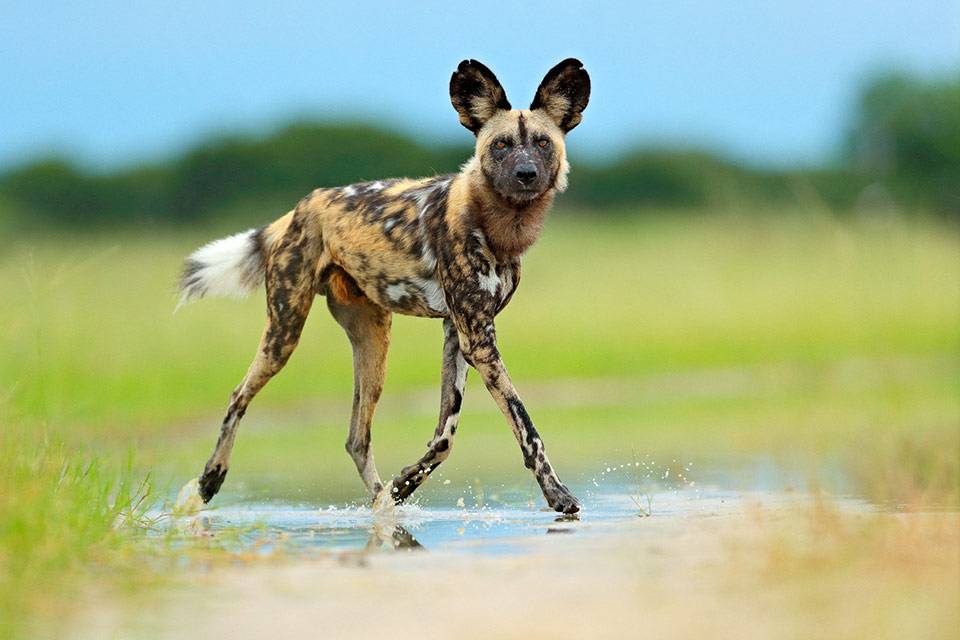
African Safari Animals - Area's to find species of Wild Dog?
The African Wild Dog is found in several sub-Saharan countries like South Africa, Botswana, Zambia, Kenya, Zimbabwe and Tanzania where countries have large protected areas.
Their nomadic movements make simple estimates of their distribution difficult. Until very recently, the range of the Wild Dog included much of sub-Saharan Africa, apart from rainforest areas and deserts. Now, however, they have been eradicated from most of their range, they are extinct in most countries in West and Central Africa, and in the East and the South, they are confined to areas where human population density remains low.
Endangered - African Safari Animals
The major reasons why African Wild Dogs are so endangered are reasonably well understood. These include extreme sensitivity to habitat fragmentation as a consequence of wide-ranging behaviour, conflict with livestock and game farmers, accidental killings by snares and road accidents as well as infectious disease.
All of these causes are associated with human encroachment on African Wild Dog habitat. With the Wild Dog population given as decreasing (IUCN) it is unlikely to be a reversible trend across the majority of this endangered species’ historical range. (IUCN)
It’s believed that the total wild dog population is between 3000 and 5000 individuals, that’s roughly 600 to 1000 packs. However, exact figures are not known because their population is severely fragmented. What is known is that the African wild dog is the second most endangered carnivore on the planet
Identification
The wild dog has a ‘painted’ coat of fur, with haphazard markings. It is a colourful, patchy coat, mottled with blotches of different colours including white, brown, black, red, and yellow. Wild-dogs have large bat-like ears and a bushy tail with a white tip, that it is said to serve as a ‘flag’ to keep the pack in contact while hunting.
No two wild dogs are marked exactly the same, making it easy for them to identify individuals. This individual unique coat pattern makes it possible for researchers to identify every individual in a population with certainty.
African wild dogs live in packs averaging from seven to 15 members and sometimes up to 40. Before the recent population decline, packs of up to 100 were recorded. Within the pack, these canines have a unique social structure. They cooperate in taking care of the wounded and sick members, there is a general lack of aggression exhibited between members of the pack, and there is little intimidation among the social hierarchy.
Every hunting pack has a dominant pair. They are usually the only pair that remains monogamous for life. Wild dogs also have a large range of vocalisations that include a short bark of alarm, a rallying howl, and a bell-like contact call that can be heard over long distances. Elaborate greeting rituals are accompanied by twittering and whining.
Some Wild Dog Facts:
Size & Weight
African Wild Dogs weigh between 20-34 kg (44-75lbs). Females are generally larger than males and they may reach a body mass of 34 kg (lbs) while males have an average body mass of 20 kg (44 lbs).
Males and females are similar in appearance though the females are generally larger than the males. Wild dogs total length is about 1.22 m (4 ft, including the tail) with a shoulder height of 65cm – 75 cm (2.1 to 2.5 ft). They are the only canid species lacking dewclaws on its front legs.
Habitat
African Wild Dogs can be found in areas of a moderately dense bush as well as open plains and savannas even woodlands or broken woodlands where they hunt for a wide variety of prey. Like most predators, they play an important role in eliminating sick and weak animals, thereby helping maintain the natural balance and improve prey species.
Wild dog can run long distances at speeds up to 56 kph (35 mph). Of the large carnivores, wild dogs are probably the most efficient and successful of hunters, with ‘targeted’ prey rarely escaping. These magnificent animals can hunt and roam over long distances of up to 250 sq km and often travel up to 50 km a day.
Their survival is dependent on the pack. A wild dog by itself is not that much of a threat to other animals, but a pack is a different story.
Diet
Wild Dogs prey mainly on small to medium-sized animals, of which the Impala is a favourite prey species. In East Africa, they have been recorded to hunt prey as large as Wildebeest and Zebra.
Wild Dogs hunt in packs, and all individuals collaborate in a team effort to chase and wear out pursued prey to exhaustion. Once brought to a standstill, the prey is killed by all the dogs tearing it apart.
Reproduction
Female Wild Dogs are termed ‘bitch’ while the males are termed ‘dogs’ just as all canines. Bitches give birth to ‘Pups’.
Wild Dogs are what as known as seasonal breeders. In South Africa, Wild Dogs are born in Midwinter (Jun-Sept).
- Known as the ‘Alpha pair’, the dominant male and female are the only dogs to breed in a wild dog pack. other members forego the right to breed and act only as helpers in the pack.
- Whelping generally occurs during the months of April to September
- The Wild Dogs gestation period is 70 days.
- The female has a litter of 2 to 20 pups, the female cannot suckle offspring for too long.
- From the age of three weeks, milk is supplemented with regurgitated meat brought to the pups by other pack members.
- A litter is safeguarded in a ‘Den’ (burrow).
Fun Facts:
- Wild dogs and domestic dogs are descended from wolves
- Wild dogs can’t be domesticated.
- Domestic dogs and wild dogs can not interbreed.
- Wild dogs have no ‘dewclaw’, domestic dogs have them.
- Wild dogs live in tightly-knit social groups of between two and 27 individuals. They are strongly bonded. They’ll even look after injured dogs, bringing them food until they recover. The average wild dog litter consists of 10 pups, the highest number of any canid.
- Even though they are much smaller than lion and leopards, wild dogs have a higher success rate when it comes to killing prey.
- A wild dog’s vocalizations go well beyond that of a domestic dog. They greet each other with twittering and whining sounds, and when one dog has lost the group, it will make an owl-like “hoo” call to find the pack.
- The alpha female is the core of the pack – leading her pack from its formation until she dies
- The 80% success rate in painted wolf hunts can be attributed mainly to the coordinated nature of the pack.
- Wild dogs are social animals and live in what is known as a pack
Where to find Wild Dog
You can find ‘Wild Dog’ in the following area’s.
South African Wild Dog (Lycaon pictus pictus)
- Mana Pools National Park – Zimbabwe
- Selous Game Reserve – Tanzania
- Moremi Game Reserve – Botswana
- Kruger National Park – South Africa
- South Luangwa National Park – Zambia
- Madikwe Game Reserve – South Africa
East African Wild Dog (Lycaon pictus lupinus)
Wild Dog Video's
More wild dog Video’s
5. Impala (Aepyceros melampus)
Family: Bovidae
The common Impala (Aepyceros melampus) is a medium-sized two-tone rufous-fawn antelope, a herbivore found in Eastern and Southern Africa and is one of the most abundant and most graceful of all Africa’s antelopes that roam the African savanna’s and bush.
There is also a sub-species of this graceful antelope, the Black-faced Impala (Aepyceros melampus petersi) which is significantly larger and darker than the common Impala.
Impala plays a significant role in the local food chain due to feeding upon shrubs and grasses, which give them their energy as well as increase their fat and muscles. In addition, impalas, along with other animal species of the area, are key prey items for local predators such as lions, leopards and hyenas.
Impalas are diurnal, which means they are most active in the early morning and right before sunset. During the rainy season, impalas gather in groups of hundreds. In the dry season the herds roam together to look for food. During the rainy season, males can be territorial and will herd females around a territorial area.
They are very social animals that live in one of three different types or groups:
- Territorial Males – Accumulate females (Hareem) and guard them against neighbouring males.
- Bachelor Herds – Groups of males remain in relatively close contact. Bachelor herds of young or old males will interact peacefully, but middle-aged males mostly spar or avoid one another.
- Herds of Females – All-female herds are groups of females, commonly with calves that disperse soon after weaning.
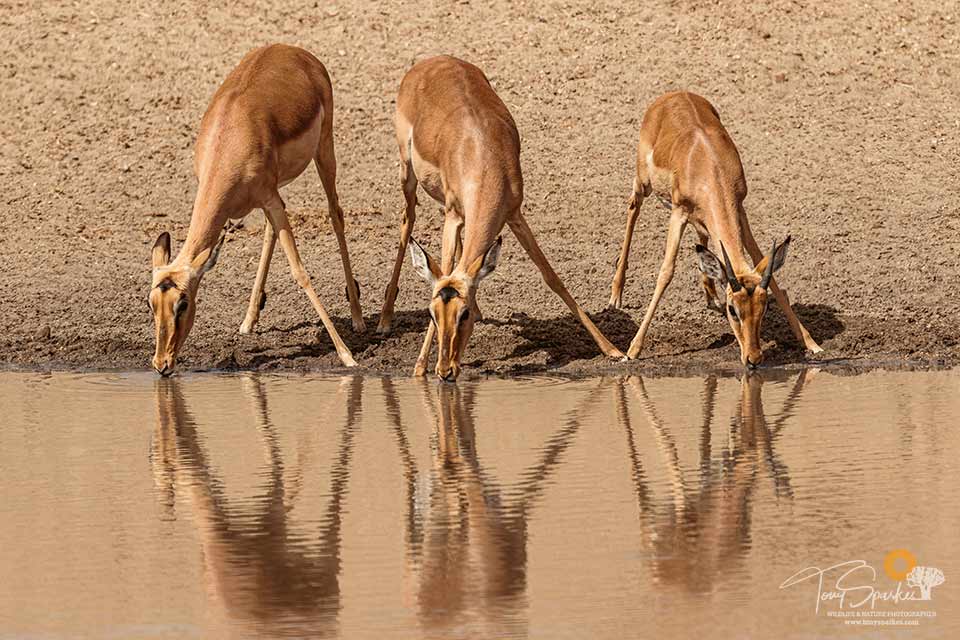
African Safari Animals - Area's to find species of Impala
Many large and small herds of Impala (Aepyceros melampus) can be found in most game reserves and nature reserves.
From Eastern Namibia, South Eastern South Africa all the way up the central and eastern side of Southern Africa and into East Africa and as far as Southern Kenya and Uganda. (Purple on the map opposite)
Black-faced Impala (Aepyceros melampus petersi) can be found in reserves in Northern Namibia and Southern Angola. (Green on the map opposite)
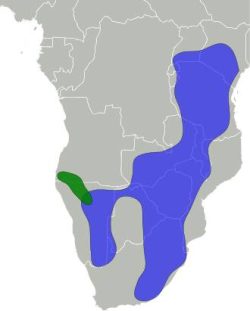
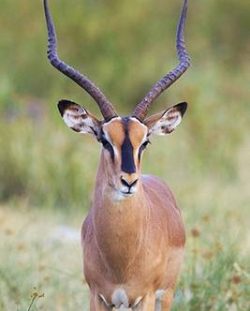
Endangered - African Safari Animals
(IUCN) classifies the common Impala population as ‘stable’ and the species is of least concern generally. The black-faced Impala, however, is classified as a vulnerable species, as of 2016, fewer than 4000 were estimated in the wild. Though there are no major threats to the survival of the common Impala, poaching and natural calamities have significantly contributed to the decline of the black-faced impala.
Identification
The glossy coat of the common impala shows a two-tone colouration with a reddish-brown back and tan flanks; these are in sharp contrast to the white underbelly. Facial features include white rings around the eyes and a light chin and snout. The ears are tipped with black. Black streaks run from the buttocks to the upper hind legs. The bushy white tail features a solid black stripe along the midline.
Black-faced Impala
Distinctive of the black-faced impala is a dark stripe, on either side of the nose, that runs upward to the eyes and thins as it reaches the forehead. Other differences include the larger black tip on the ear and a bushier and nearly 30% longer tail in the black-faced impala.
Some Impala facts:
Size & Weight
The impala is a medium-sized, slender antelope with a body length including the head of around 130 cm (51 in). Males reach approximately 75–92 cm (30–36 in) at the shoulder, while females are 70–85 centimetres (28–33 in) tall.
Males typically weigh about 53–76 kg (117–168 lb) and females 40–53 kg (88–117 lb). Sexually dimorphic, females are hornless and smaller than the males. Males also grow slender, lyre-shaped horns 45–92 cm (18–36 in) long. These are generally used for fighting (especially during the rutting season) and protection of the skull.
Habitat
Impalas are usually encountered in ecotone regions which are the transitional zones between two habitats such as grassland and woodland. Habitat choices differ seasonally, woodlands are preferred in the wet season and savannahs in the dry season. Generally, though, Impala prefers woodland with little undergrowth as well as low to medium height grassland. As with any African habitat, areas closer to reliable water sources are preferred and are a highly valuable resource.
Another important factor that could influence habitat choice is vulnerability to predators; impala tends to keep away from areas with very tall grasses as predators could be and often are concealed there.
Diet
Impala are herbivores, being mixed feeders, they graze and they browse on whatever food source is best seasonally. This gives them a huge advantage over other antelopes that either just grazes on grass or just browses leaves. When grazing, they prefer softer grasses that have higher nutritional value, rather than some of the tougher grasses that may be consumed by other grazers.
In the summers Impala usually graze a higher percentage of green grass as it is more protein-rich with less secondary compounds to digest, and in winter months a higher percentage of browsing is done, normally on Acacia trees, now known as (Vachellea)
Reproduction
Female Impala is termed ‘Ewes’ (without horns). While the males are termed ‘Rams, (with horns).Ewes give birth to ‘Calf or Lamb’.
- At the start of autumn males ‘Rut’ against one another with direct challenges and horn, clashes establish dominance, only the strongest males can hold territories.
- Rutting behaviour will induce the adult females into oestrous where mating follows.
- The gestation period for a female Impala is 180-220 days
- Before giving birth to a single calf, a female will leave the herd.
- After a day or two, the mother impala will bring her calf back to the herd.
- A ewe is sexually mature at two years of age.
- Young rams can breed as yearlings but are prevented to do so by territorial rams, which dominate reproductive opportunities.
Fun Facts:
- Impalas when threatened, usually ‘snorts’ and makes ‘barking’ calls in order to warn the members of the herd.
- Impalas are also capable of hearing and recognising the alarm calls of other species.
- Impalas are fantastic jumpers. They can leap as far as 10m (33 ft )and as high as 3m (10 ft)
- For safety, female impalas typically give birth by noon, the time when most of their predators rest.
- On their rump, Impalas have the identifying “M” like marking, due to which they are occasionally called “McDonald’s of the bush” or sadly the Fast Food of the bush.
- The life span of an Impala in the wild is about 12years
- The territorial males hold territories where they form harems of females.
- Male Impalas territories are demarcated with urine and faeces and are defended against the juveniles or other male intruders.
- ‘Stotting’ (also called pronking or pronging) is a behaviour in which antelope spring into the air, lifting all four feet off the ground simultaneously. Its an activity often carried out by Impalas.
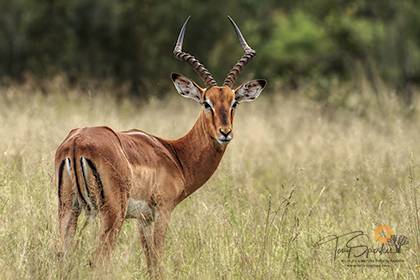
Where to find Impala
- You can find ‘Impala’ in the following area’s.
Common Impala (Aepyceros melampus)
- Mana Pools National Park – Zimbabwe
- Chobe National Park – Botswana
- Masi Mara game Reserve – Kenya
- Kruger National Park – South Africa
- South Luangwa National Park – Zambia
- Madikwe Game Reserve – South Africa
Black-faced Impala (Aepyceros melampus petersi) - Etosha National Park – Namibia
- Southern Angola
Impala Video's
More Impala Video’s
Conclusion
For those of you who have experienced the sheer thrill and beauty of an African safari, one can understand there is nothing quite like it on earth. When you are close to large African animals, so close that you can hear them breathe, hear their hearts beat, it is hard to describe such experiences to anybody.
However, an African safari can mean so much more to those who choose to travel to the dark continent when you have some insight into those African safari animals you will see. That extra understanding will provide answers to your questions and enhance your enjoyment. I hope you have learnt something from our post?
To love Africa you must know Africa……
- African Wildlife Photography Tips - February 23, 2020
- Low Light Wildlife Photography - November 26, 2019
- Bonamanzi Game Reserve - November 21, 2019

